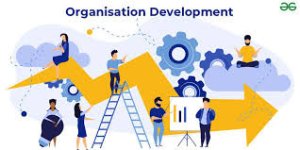Organizational Development: Driving Change for Growth
Organizational Development (OD) is a systematic approach to improving organizational effectiveness. It involves planned interventions aimed at enhancing the overall performance of a company by aligning its strategies, structures, and processes. OD focuses on developing the organization’s ability to adapt to changes, solve problems, and improve its culture, making it a vital aspect of long-term business success.
Organizational development is rooted in the idea that a company’s success is tied to its ability to evolve and grow. It involves changing how an organization functions, how its people interact, and how work is managed to achieve greater efficiency, productivity, and satisfaction.
Key Elements of Organizational Development
- Strategic Planning
- One of the primary goals of OD is to ensure that the organization's structure, culture, and processes are in alignment with its strategic objectives. Strategic planning involves setting clear goals, defining the direction for growth, and identifying the steps needed to achieve those goals.
- Leadership Development
- Effective leadership is critical to organizational success. OD programs often include leadership development initiatives aimed at building strong leaders who can guide teams, inspire employees, and manage change effectively.
- Culture Change
- Organizational culture encompasses the values, beliefs, and behaviors that define how things are done within the company. OD helps organizations shift their culture to support desired outcomes, such as improved teamwork, innovation, and employee engagement.
- Employee Engagement and Empowerment
- Organizational development involves empowering employees by providing them with the skills, autonomy, and confidence to contribute effectively. Engaged employees are more motivated, leading to higher productivity and better performance across the company.
- Team Building and Collaboration
- OD interventions often focus on improving teamwork and collaboration between departments and employees. This may involve team-building exercises, conflict resolution training, and workshops designed to improve communication and coordination.
Why is Organizational Development Important?
- Adaptability to Change
- In today’s fast-paced business environment, organizations must be adaptable to stay competitive. OD helps companies develop the agility needed to respond to external changes, such as market shifts, technological advancements, and regulatory changes. This enables businesses to stay ahead of the curve.
- Improved Performance
- Through better leadership, effective communication, and enhanced employee engagement, OD initiatives contribute directly to improved organizational performance. A well-developed organization operates more efficiently, delivers higher-quality products or services, and increases profitability.
- Enhanced Employee Satisfaction
- Organizational development initiatives often include strategies for improving the work environment. When employees are empowered, valued, and given opportunities for growth, their satisfaction increases. A happy workforce leads to reduced turnover and improved retention.
- Problem-Solving Capacity
- OD enables an organization to become better at identifying, addressing, and solving problems. By fostering a culture of collaboration and open communication, employees are better equipped to deal with challenges effectively and creatively.
- Sustainable Growth
- OD supports long-term growth by creating a solid foundation for success. It helps businesses optimize their resources, enhance their talent pool, and streamline processes, ensuring continued expansion and development.
OD Interventions
Organizational development interventions are planned, structured efforts aimed at improving the effectiveness of an organization. These interventions can take many forms, depending on the needs of the company. Common OD interventions include:
- Training and Development Programs
- These programs are designed to enhance employees' skills, knowledge, and competencies, helping them perform their roles more effectively. Training might cover leadership development, technical skills, communication, and other areas essential for success.
- Organizational Assessments
- Regular assessments help businesses understand their current state and identify areas for improvement. This can include surveys, interviews, and focus groups to gather feedback from employees, management, and customers.
- Change Management
- Implementing change is often one of the most challenging aspects of OD. Change management strategies help organizations navigate transitions smoothly by providing a structured approach to introducing and managing change.
- Conflict Resolution and Mediation
- OD also includes techniques to address and resolve conflicts between employees or teams. Conflict resolution interventions improve interpersonal relationships, reduce misunderstandings, and promote a healthier work environment.
- Job Design and Role Clarification
- Job design interventions focus on making work roles more effective and satisfying for employees. This might involve redesigning tasks, adjusting workloads, or redefining roles to better align with organizational goals.
Challenges in Organizational Development
While OD is an essential tool for growth, organizations often face several challenges in implementing it effectively:
- Resistance to Change
- Employees may resist change, especially if they feel it threatens their job security or disrupts established routines. Overcoming this resistance requires clear communication, leadership support, and employee involvement in the change process.
- Lack of Leadership Support
- Organizational development efforts require strong leadership to succeed. Without commitment and active support from leadership, OD initiatives may fail to gain traction.
- Inadequate Resources
- Implementing OD programs requires adequate financial, human, and time resources. Lack of investment can hinder the success of OD initiatives and lead to poor outcomes.
- Cultural Barriers
- Organizational culture plays a crucial role in the success of OD. If the culture is resistant to change, OD efforts may face significant obstacles. Shifting culture requires a long-term commitment from leadership and all employees.
Conclusion
Organizational development is a critical process for businesses looking to enhance their efficiency, adaptability, and long-term success. By focusing on leadership, culture, communication, and employee engagement, OD helps organizations evolve and thrive in an ever-changing business landscape. With the right strategies, interventions, and support, organizations can achieve sustainable growth, improve performance, and create a positive workplace environment for all employees.

